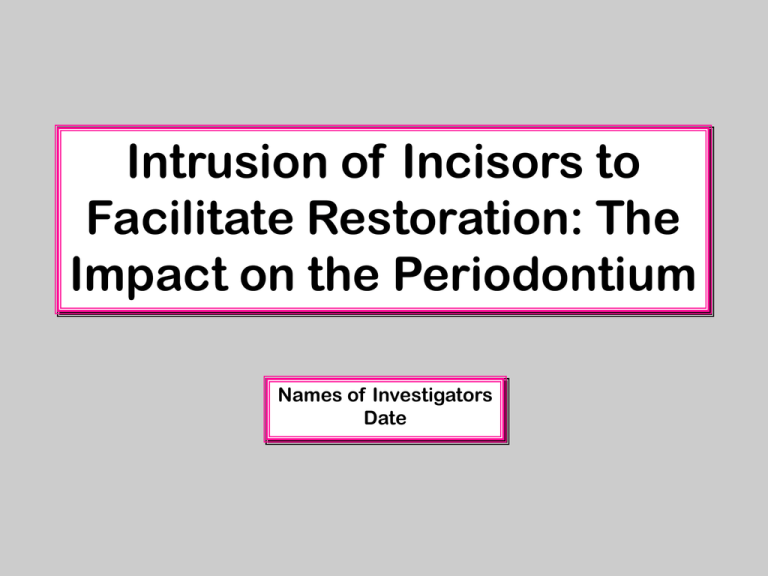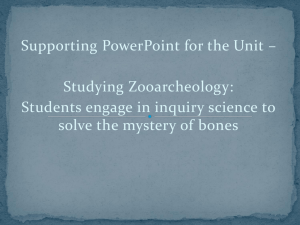E-Poster Research Sample
advertisement

Intrusion of Incisors to Facilitate Restoration: The Impact on the Periodontium Names of Investigators Date Background and Purpose This 60 year old male had severe attrition of his maxillary and mandibular incisors due to a protrusive bruxing habit. The patient’s restorative dentist could not restore the mandibular incisors without significant crown lengthening. However, with orthodontic intrusion of the incisors, the restorative dentist was able to restore these teeth without further incisal edge reduction, crown lengthening, or endodontic treatment. When teeth are intruded in adults, what is the impact on the periodontium? The purpose of this study was to determine the effect of adult incisor intrusion on the alveolar bone level and on root length. Materials and Methods We collected the orthodontic records of 43 consecutively treated adult patients (aged > 19 years) from four orthodontic practices. This project was approved by the IRB at our university. Records were selected based upon the following criteria: • incisor intrusion attempted to create interocclusal space for restorative treatment or correction of excessive anterior overbite • pre- and posttreatment periapical and cephalometric radiographs were available • no incisor extraction or restorative procedures affecting the cementoenamel junction during the treatment period pretreatment pretreatment Materials and Methods We used cephalometric and periapical radiographs to measure incisor intrusion. The radiographs were imported and the digital images were analyzed with Image J, a public-domain Java image processing program developed at the US National Institutes of Health. All measurements were made to the nearest 0.01mm. We used the incisor centroid, defined as a point on the longitudinal axis of the tooth that is independent of any change in inclination, to measure intrusion. pretreatment posttreatment Materials and Methods We estimated the centroid of the central incisors to be 33 percent of the distance from the midpoint of a line connecting the mesial and distal alveolar crest to the root apex. After we identified the centroid on the pretreatment radiographs, it was transferred to the pre- and posttreatment cephalometric radiographs using the labial CEJ as a common reference point. We used a reference plane relative to the centroid to evaluate whether true intrusion had been achieved: we used the mandibular and palatal planes as the skeletal reference structure for the incisors. pretreatment posttreatment Materials and Methods We measured alveolar bone level and root length on periapical radiographs. A single examiner, who was blinded to the record period, evaluated the position of the CEJs, the level of the alveolar crest, and the root apices of the central incisors. This same examiner measured bone level as the vertical distance from the proximal CEJ to the alveolar crest. The examiner evaluated both central incisors. To insure projection similarity, we used the periapical radiograph centered on the midline for analysis. We omitted all nonmeasurable sites from the analysis. pretreatment posttreatment Data Analysis We calculated the differences between pre- and posttreatment for all data. We compared alveolar bone levels and root lengths at all sites by using a paired t test. For the intrusion versus no-intrusion subgroup analysis, we averaged the data for each person and compared the results with a t test for independent samples. We used multiple linear regression to determine the associations among variables. We assessed the examiner’s reliability by computing intraclass correlation coefficients for repeated measures. The coefficients ranged from 0.84 to 0.99 indicating high reliability. Results We found that the mean amount of intrusion for the entire sample was 2.29 millimeters. Relative to the CEJ, alveolar bone level remained relatively constant after intrusion. In other words, the bone level followed the tooth during the intrusive movement. All sites exhibited significant bone loss; however, the change was minimal, with a mean loss of 0.32mm. In general, there was a trend for the mesial sites to lose more than the distal sites, but the difference was not statistically significant. Results All intruded incisors underwent significant root resorption during treatment. There was considerable variation between people as indicated by the high standard deviations within the sample. The mean root resorption was 1.73 millimeters for maxillary incisors and 1.37 millimeters for mandibular incisors. Approximately 10 percent of root length was lost during intrusion. Results Within the initial sample of 43 patients, 20 had central incisors in one or both arches that were not intruded. We derived a no intrusion group that excluded the values for any nonintruded incisors. The groups were wellmatched with regard to age, treatment time, and pretreatment bone level and root length. There was no statistical difference between the groups for either bone level or root resorption. Results Within the sample of 43 subjects, 16 patients had both maxillary and mandibular central incisors that were intruded more than 1.0mm. The mean intrusion for both groups was similar. However, the pretreatment bone levels and root lengths were significantly different. Mandibular incisors tended to have less bone support and maxillary roots were longer. There was no statistical difference in bone level change and root resorption between intruded maxillary and mandibular incisors. pretreatment posttreatment Results On the basis of the multiple linear regression model, we found no association between the change in bone level and age, gender, treatment time, amount of intrusion and pretreatment bone level. Similarly, we found no association between root resorption and age, gender, treatment time and amount of intrusion. However, there was a significant association between root resorption and pretreatment root length (P <.0001). The coefficient for this variable was 0.085, indicating about 0.085mm of additional root resorption per millimeter increase in root length. Conclusion / Clinical Application Orthodontic incisor intrusion in adults is a valuable treatment adjunct to the restorative management of incisal wear. This type of treatment will permit restoration of worn and supererupted teeth usually without crown lengthening and/or root canal therapy. Our findings suggest that the benefits of less tooth preparation and a more conservative final restoration far outweigh the minimal iatrogenic effect on alveolar bone level and root length.










